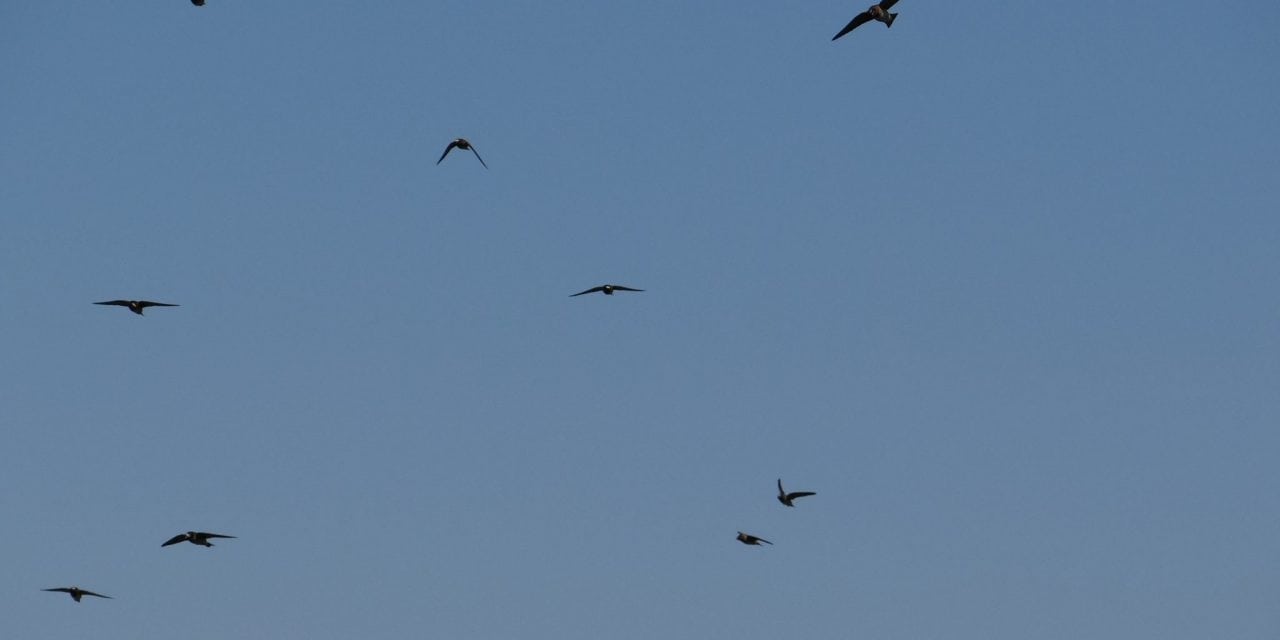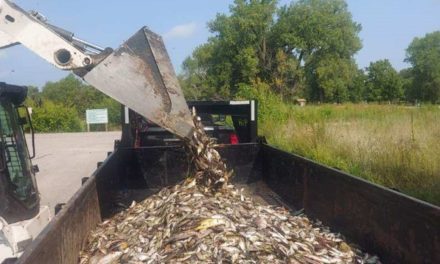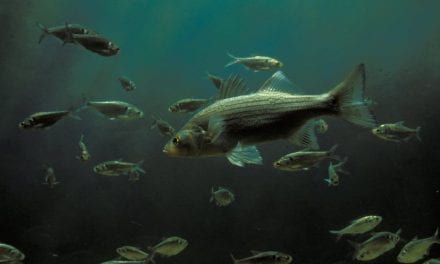You can’t miss them. You really can’t.
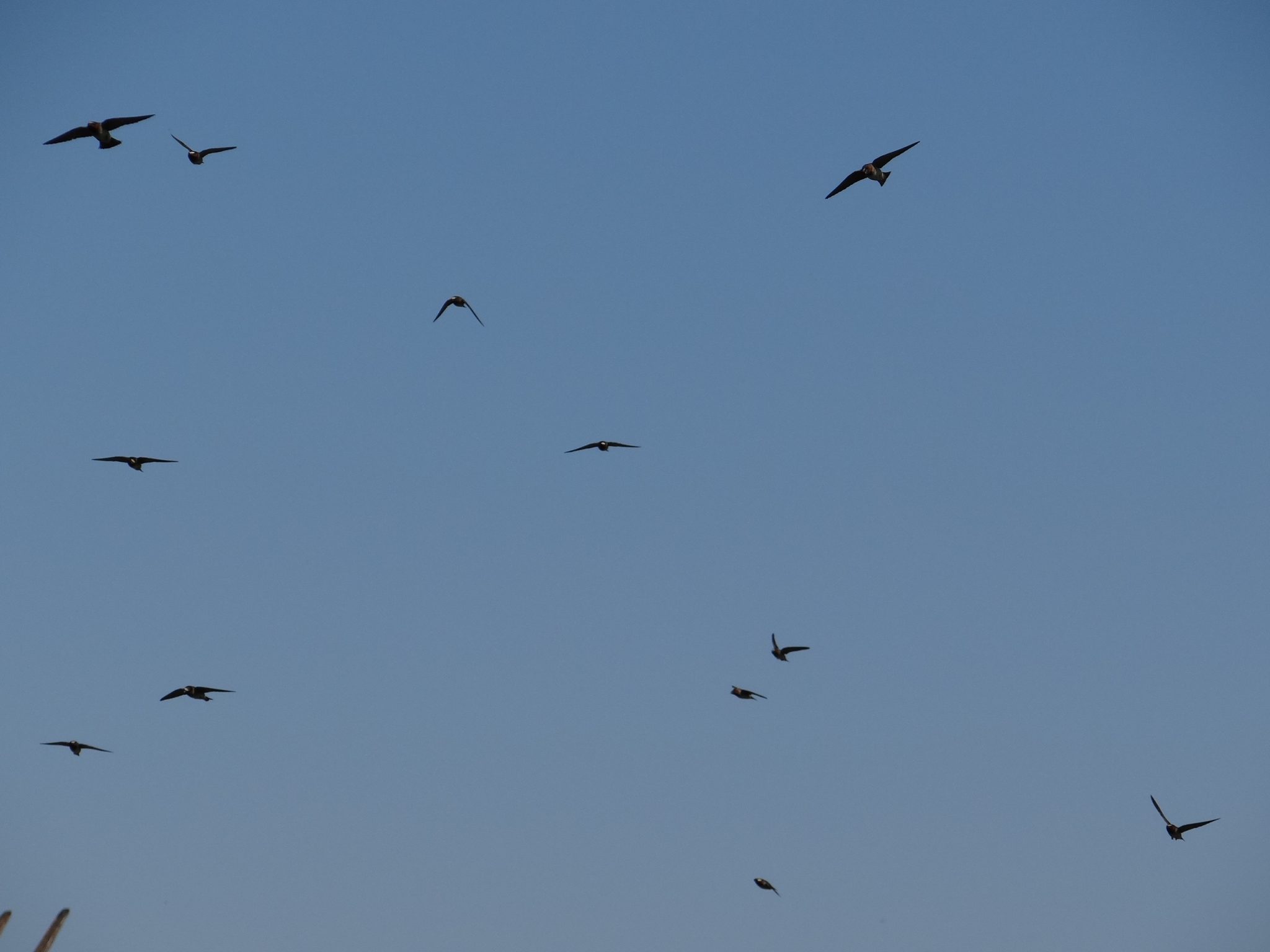
Around bridges over rivers or creeks this time of year, they immediately snatch your attention. Maybe it’s their sheer numbers (hundreds, if not thousands of them) and their extreme aerial acrobatics that catch your eye. Or, maybe it’s them coming in and out of their clusters of gourd-like mud nests clinging to the walls beneath bridge overhangs that capture your awareness. Or, perhaps it is the throng of bird activity along the muddy bank of a stream or mud hole that causes you to take notice.
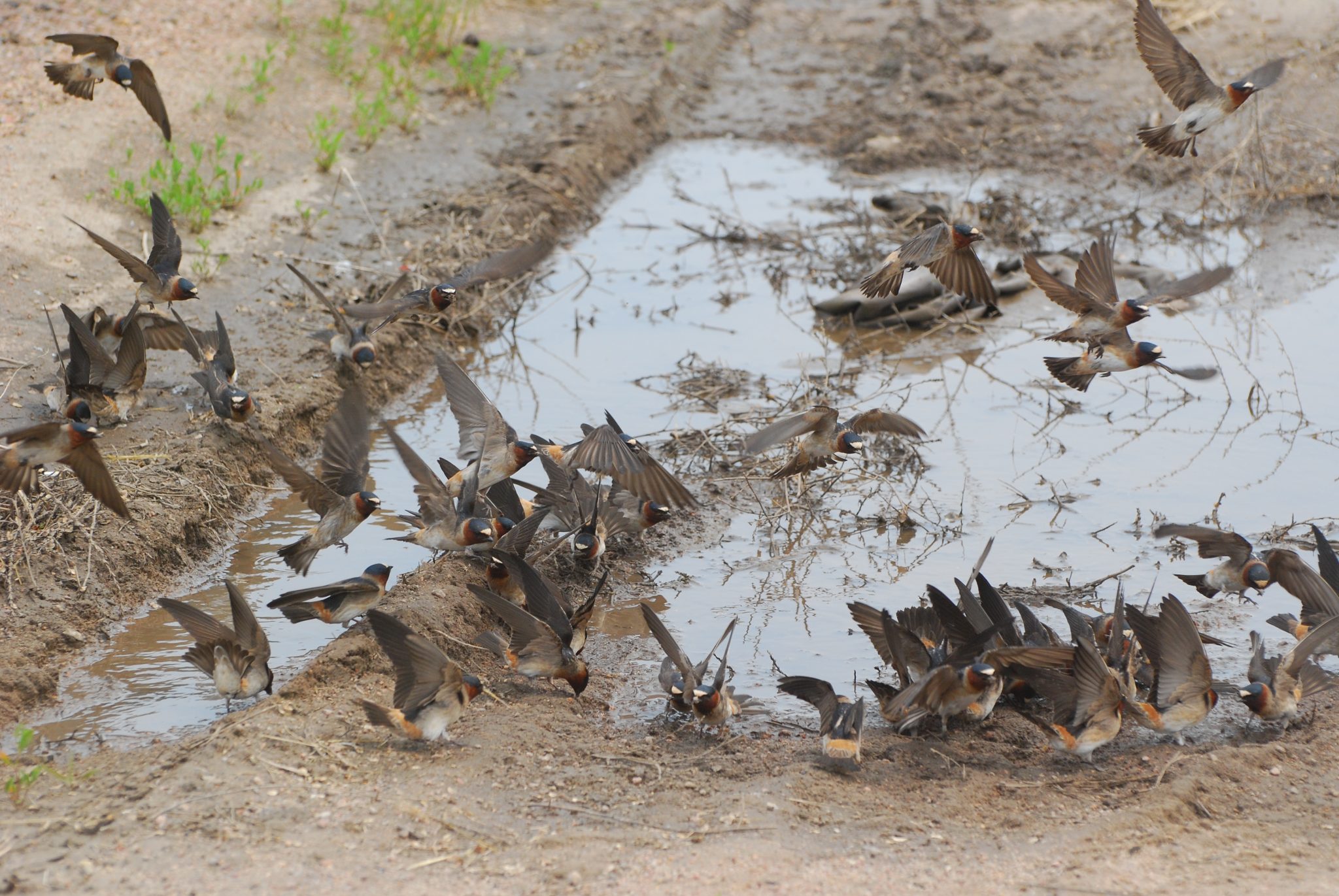
Whatever the case may be, you have been drawn into the exciting world of the cliff swallows.
I have seen them now for four years each spring and summer around the bridges along Omaha’s popular Big Papio Creek Trail while on my fitness walks.
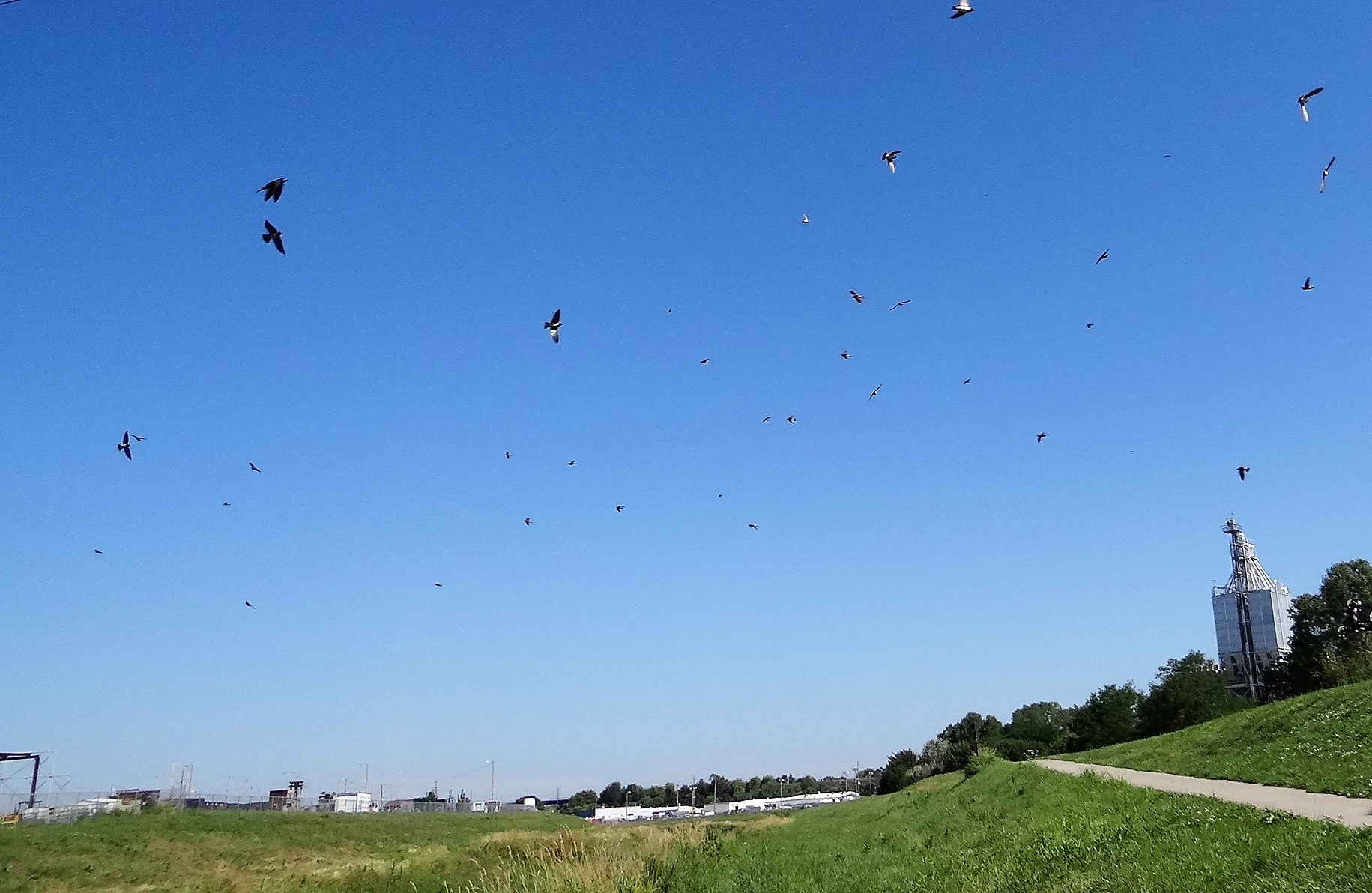
I always take the time stop and watch them with intrigue and amazement. As recreational bird watching experiences go, watching cliff swallows is one of the best thrills I can imagine. Their entertainment value is high!
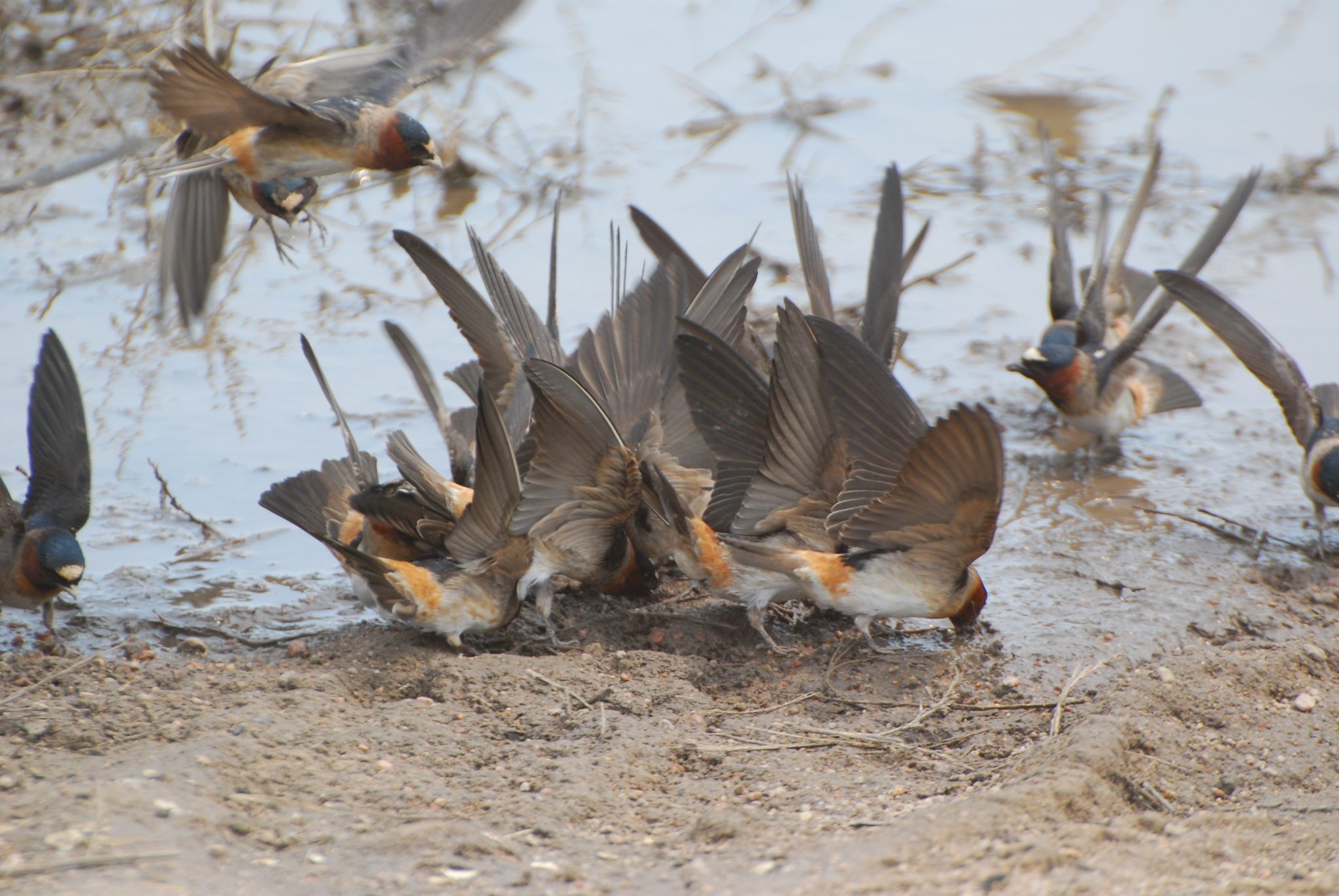
So, I decided to take a closer look at this colorful little bird — the cliff swallow (Petrochelidon pyrrhonota), and delve into its interestingly unique life.
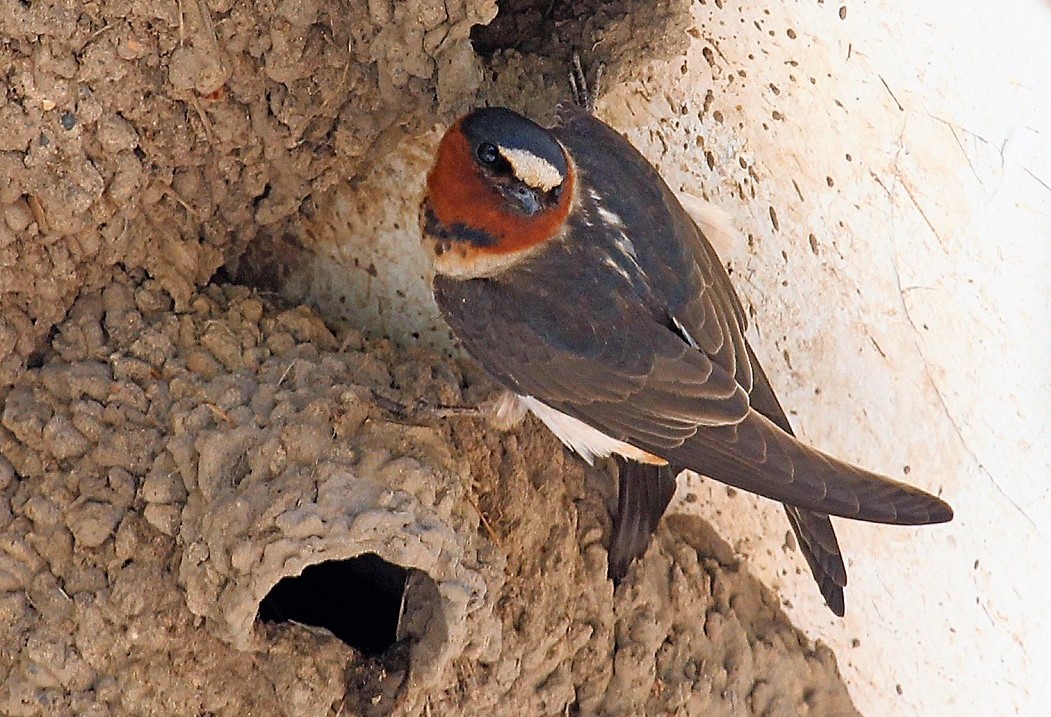
You will find this information fascinating!
One of the things I discovered is that we have one of the foremost experts and researchers on the cliff swallow right here in Nebraska — Dr. Mary Bomberger Brown, Ornithologist at the University of Nebraska-Lincoln’s School of Natural Resources.
Bomberger Brown and Dr. Charles Brown from the University of Tulsa as well as a host of students, continue to conduct this award-winning, landmark, evolution study (1982-present) on cliff swallows in southwest Nebraska.
They have learned many things thus far.
According to Bomberger Brown, climate change is causing the birds to arrive and begin nesting earlier with warming temperatures; the effect is greater with larger colonies. As birds began nesting on bridges and culverts in the early 1980s, they began living in closer association with vehicles—birds with longer wings were not as aerodynamic as birds with shorter winger, so they were more likely to be hit and killed by vehicles. Only short-winged individuals survived and reproduced, so we now have short-winged Cliff Swallows.
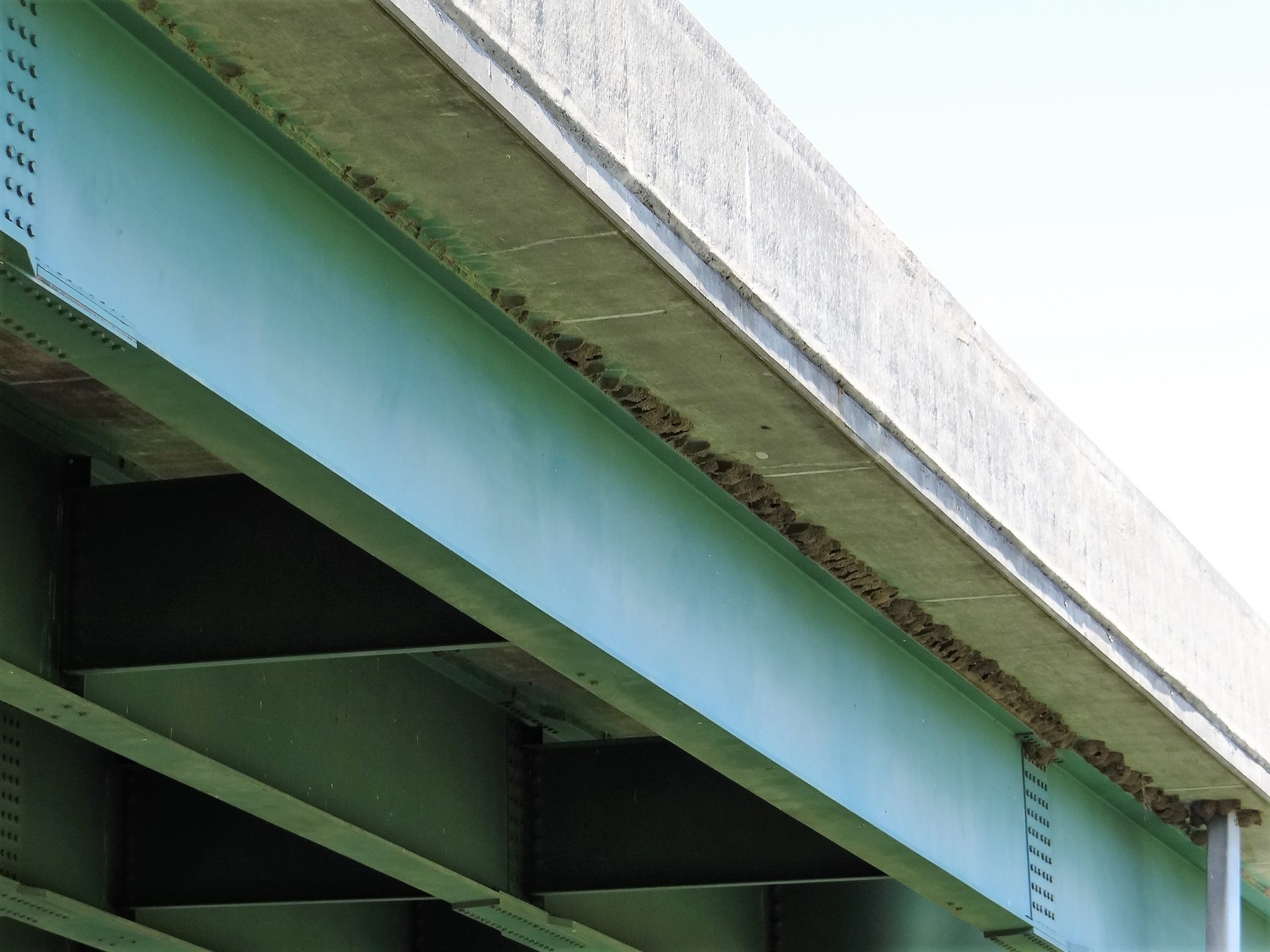
The original nesting sites of cliff swallows were cliffs and walls of canyons. Human-made structures, such as bridges, culverts and overpasses, as well as agricultural activities, have increased the number and distribution of suitable nesting sites, and cliff swallow populations have increased accordingly.
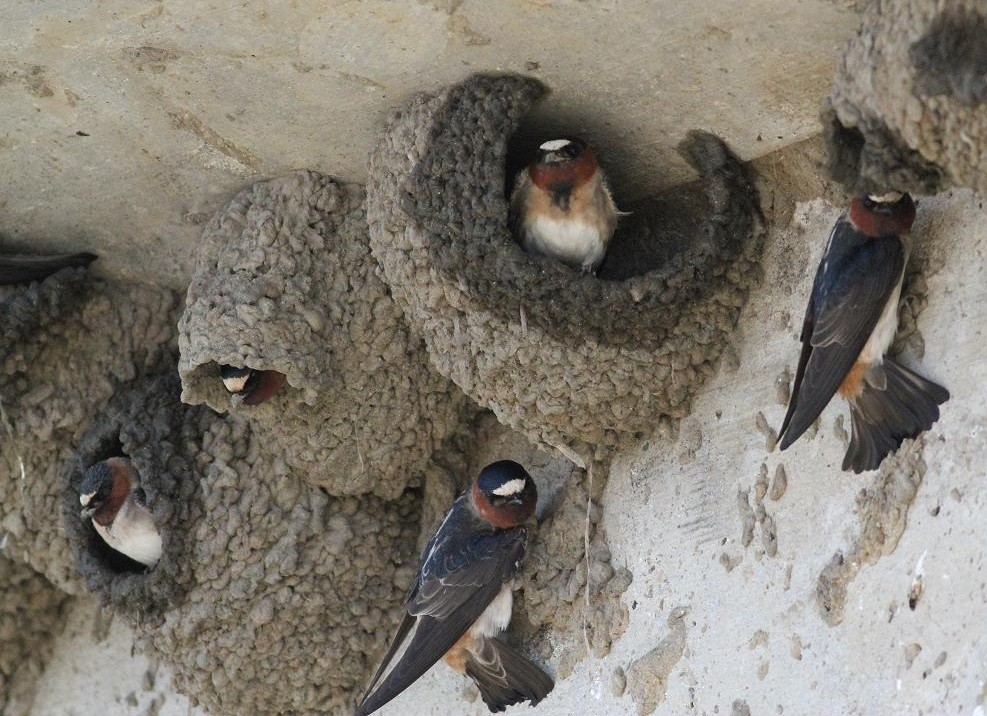
They are widely seen in Nebraska this time of year, most notably underneath bridges.
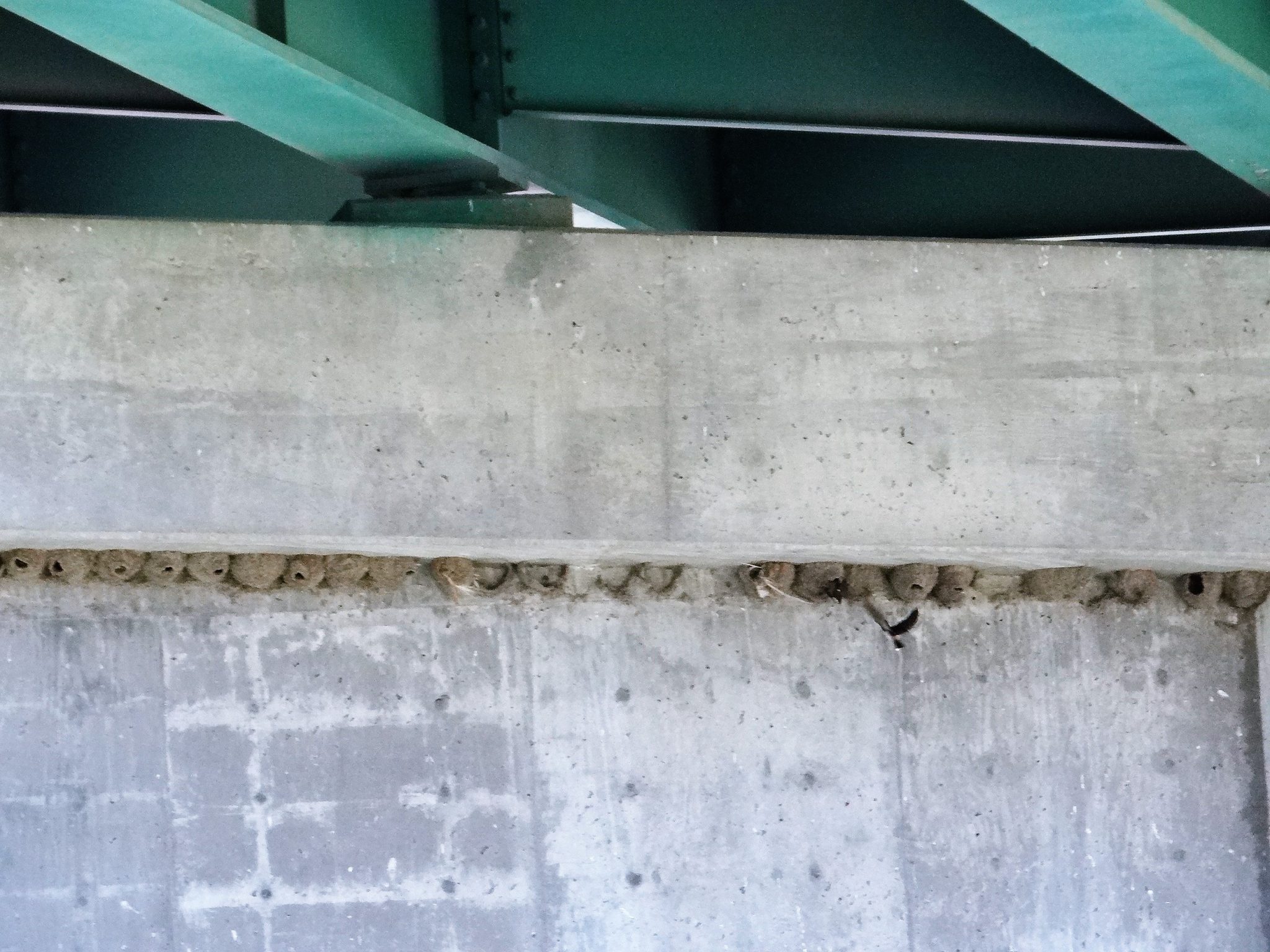
Time to learn more about the cliff swallow you and I see. They have a captivating life story.
The Bird’s Appearance
A member of the passerine bird family consisting of both swallow and martin species, the cliff swallow is a small bird with a short, wide bill forming a large gape perfectly adapted for catching insects on the wing. It’s average body length (from the tip of its bill to the tip of its tail) is 5.5 inches long. The cliff swallow’s wing length runs about 4 to 4.5 inches. Adults weigh approximately 1 ounce. The cliff swallow is distinguished from all other birds by having an orange rump patch, triangular white forehead patch, dark blue black, brown-black wings and tail, white belly and chestnut throat. Males and females look alike throughout the year. Juvenile Cliff Swallows are grayer and paler overall, but their faces are quite variable in appearance. The variation in the facial mottling pattern makes them individually recognizable, which is unique among birds.
“Birds of A Feather Flock Together”
Cliff swallows are among the most social land birds in North America and the most social of the swallows. They all live together in colonies, a natural survival strategy (safety in numbers, you know). Cliff swallows are truly social in everything they do. They preen, feed, drink and bathe in groups. Their colonial lifestyle has led to the evolution of many complex behaviors. As examples, the cliff swallows forage together in big bunches (while sharing information about the location of food), lay eggs in or move eggs to their neighbors’ nests and even spend the winter in large aggregates.
Calls And Song
The Nebraska Bird Library illustrates the calls/song of the cliff swallow as follows: “A rolling churr” note (I think it sounds like the squeaking of a door with rusty hinges). Its song is a series of squeaking and grating notes given in flight.” The cliff swallow even has a special food call vocalization they use during bad weather to announce where food is to be found. Also, cliff swallows have a sophisticated vocal system for recognizing their own young within a colony. Alarm calls are heard at the colony of cliff swallows while the birds are flying over-and-around the colony entrance way, they serve as a signal of danger close to the nests. When this call is heard by the other colony members, a mass fleeing of birds out and away from their nests is observed.
Feeding And Getting A Drink
The feeding habits of cliff swallows consist of catching flying insects that swarm or are in a mass. Actually, they are aerial insectivores which means that they only feed on insects they nab in flight. Cliff swallows feed in great numbers on these insects ranging from mosquitoes to grasshoppers to midges near ground level up to roughly 50 meters. Thus, they help to control insect populations. Cliff swallows are social foragers. They observe each other’s foraging success and learn from other colony residents the locations of their live food. The more birds there are, the more quickly individuals can locate somebody who happens to know where the food is at any given time. This increased foraging efficiency is especially important when the adults are feeding chicks in their nests. Not only do cliff swallows feed in flight, they also get a drink of water in flight as well! They skim over a lake, river or creek by dipping their lower mandible in the water to scoop up some H2O.
Nesting
By instinct, cliff swallows know to build their jug-shaped nests on the sides of cliffs, canyons or bluffs, as protection from birds of prey and snakes. They’re always close to water for little globs of mud they need to construct their nests and most likely, because their food source, insects and lots of them, are found in or near aquatic habitat. So, after a pair of cliff swallows selects a colony, it takes over an existing nest or picks a space on the colony to build a new nest. Each nest is normally a juncture between a vertical wall and a horizontal overhang. Both sexes help build the nest, though the male may begin before he attracts a female. Mud is then gathered in the bill of the cliff swallows not far from the colony. The birds bring back mud pellets in their bills molding them in place with a shaking motion. The result is an enclosed, gourd-shaped structure about the size of a melon containing somewhere between 900 and 1,200 individual mud pellets. It is lined with a small cup of dried grass and perhaps a few feathers to hold the eggs, with a small, round, tubular-type hole as an entrance. The birds begin nesting activities in the Cornhusker State in the late-April to early-May time period. It takes about 1-2 weeks for the birds to construct the nest and it is patched throughout the breeding season. Within a cliff swallow colony, some females lay eggs in another female’s nest, or lay eggs in its own nest and carry one or more to another female’s nest. Each nest holds a pair of adults and 3-4 chicks. In Nebraska, colonies range from 2 to 6,000 nests in size, but the average is 400 to 500 nests. At least 2,200 birds occupy a colony.
The Young and The Creche
The incubation period for the eggs of cliff swallows is ~24 days (which is long for a passerine); eggs that hatch in 10-19 days had to be incubated elsewhere and the result of egg transfer (an adult picking up an egg from their own nest and moving it to a neighboring nest….putting their egg in more than one basket). Cliff swallow eggs are incubated by both sexes. Both the male and female feed the young approximately once per hour for about 23 to 26 days, after which time the young fledge from the nest to join sizable groups of other young in what is a creche or nursery. Both adults continue to feed the young for at least another 3-5 days, primarily locating their young in the creche by voice. Cliff swallows have one of the most variable plumages of juvenile birds. And, the distinctive facial markings that each juvenile possesses is said to assist the parents with identifying their chicks by sight, too.
Its History
Historically, according to the University of Nebraska-Lincoln’s School of Natural Resources, the cliff swallow was a bird of the American West nesting underneath horizontal rock ledges in steep, rocky terrain. It was one of the first North American bird species noted by European natural historians. It was officially described by Thomas Say who accompanied Stephen Long’s expedition into the Rocky Mountains. Lewis and Clark, along with pioneers on the Oregon Trail, frequently observed cliff swallows and wrote about them in their diaries and journals. Fossils of cliff swallows have been unearthed dating back to the late Pleistocene or Ice Age.
Migration, Breeding And Wintering
Cliff swallows are migratory birds. From March through September, they breed, nest and raise young in large colonies from Canada to Mexico. In Nebraska, they are a common spring and fall migrant and summer resident statewide. University of Nebraska-Lincoln (UNL) sources say they usually arrive in mid-April, and after their nestlings fledge, typically leave Nebraska in late-July through early-September. They arrive in their wintering areas in a large portion of South America by October and stay there until early March. Most birds spend the winter in grasslands, marshes and agricultural areas along major river basins north and northwest of Buenos Aires, Argentina. The cliff swallows do not nest while they are in South America. In both spring and fall, cliff swallows migrate in big groups only during the day. They follow the Central American Isthmus between North and South America.
Other Interesting Facts About Cliff Swallows
*Are the cliff swallows the swallows of the famous San Juan Capistrano legend? Yes, they indeed are. Legend has it that the cliff swallows return to the mission in southern California on March 19 (St. Joseph’s Day) spend the summer nesting at the mission, and then leave for South America on October 23 (Day of San Juan). Contrary to the legend, they return to Capistrano in late February, considerably earlier than the fabled March 19.
*Adult cliff swallows often return to nest at colonies where they reproduced successfully in the past. Yearling Cliff Swallows often return to the same general area where they were chicks to nest, but very rarely to the same colony.
*When cliff swallows are on the ground at along a muddy bank, you’ll always see them fluttering their wings behind their backs. This action is done to mostly keep their wings out of the mud and clean so they can take off easily for a quick flight back to colony but also to try to deter what are called ‘extra-pair copulations.’ Extra-pair copulation is a promiscuous mating behavior in monogamous species.
*Cliff swallows are socially monogamous—1 male and 1 female per nest, but are genetically polygamous—both males and females mate with multiple individuals (extra-pair copulations and fertilizations are frequent).
*Both male and female cliff swallows are able to breed when they are 1 year old and are able to breed every year of their life (on average 4-6 years, but can be up to 13 years).
*Cliff Swallows may hybridize with cave and barn swallows. Chimney swifts and white-throated swifts appear and act much like cliff swallows, but are not closely related.
*Cliff swallows glide, soar, and circle more than barn swallows do, and are often seen higher in the sky. When not in flight, swallows can be seen perched on utility wires, TV antennas, and on dead branches in large trees. Young swallows can be observed sticking their heads out of the nest, begging for food when a parent arrives.
*The most significant predators on cliff swallows are snakes that eat eggs and chicks they find in nests. In Nebraska, bull snakes are responsible for most cliff swallow nest predations.
*Cliff swallow nests are prone to external parasite infestations and colonies may not be reoccupied because of heavy infestations.
*Swallows are not a significant source of any infectious disease that can be transmitted to humans or domestic animals.
*All swallows are protected under the Migratory Bird Treaty Act of 1918 and by state regulations. It is illegal for any person to take, possess, transport, sell, or purchase them or their parts, such as feathers, nests, or eggs, without a special permit. Violations need to be promptly reported by phone to Nebraska Wildlife Crimestoppers at 1-800-742-SNAP (7627).
- BLOGGER’S NOTE: Much of the information presented on cliff swallows in this blog was compiled from the University of Nebraska-Lincoln’s School of Natural Resources, Dr. Mary Bomberger Brown, Dr. Charles Brown and the Nebraska Bird Library. Many thanks to them, and to Joel Jorgensen, Ornithologist for the Nebraska Game and Parks Commission, for providing photos and critiquing the blog’s content. Dr. Bomberger Brown’s critique was also considerably appreciated!
The post Cool Cliff Swallows (Of The Big Papio And Beyond) appeared first on NEBRASKALand Magazine.

